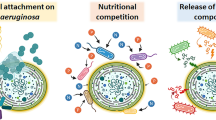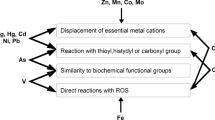Abstract
Copper toxicity to the cyanobacteriumPlectonema boryanum (UTEX 594) has been investigated in the presence of citrate and nitrilotriacetic acid (NTA) using a copper-saturated culture medium. The coppercitrate complex was biodegradable, and toxicity was dependent on the free ligand concentration. The ratio of citrate to copper also affected the extent of metal toxicity. NTA was not degraded byP. boryanum. Ligand degradation in the cyanobacterial culture increased the ionic copper concentration and caused a concomitant reduction in growth. The ecological implications of these findings are discussed.
Similar content being viewed by others
References
Allen HE, Hall RH, Brisbin TD (1980) Metal speciation. Effects on aquatic toxicity. Environ Sci Technol 14:441–443
Anderson DM, Morel FMM (1978) Copper sensitivity ofGonyaulax tamarensis. Limnol Oceanogr 23:283–295
Avakyan ZA (1971) Comparative toxicity of free ions and complexes of copper and aminoacids toCandida utilis. Mikrobiol 40:417–423
Blum R, Fogg HM (1972) Metal buffers as standards in direct potentiometric determinations of metal ion activities. J Electroanal Chem 34:485–488
Blutstein H, Shaw RF (1981) Characterization of copper-binding capacity in lake water. Environ Sci Technol 15:1100–1102
Methods of enzymatic food analysis. Citric acid determination using UV (1980) Boehringer Mannheim
Bollman RC, Robinson GGC (1977) The kinetics of organic acid uptake by three chlorophyta in axenic cultures. J Phycol 13:1–5
Butler M, Capindale JB (1975) Assimilation of citric acid and adipic acid by the blue-green algaAnabaena variabilis. Can J Microbiol 21:1372–1378
Canterford GS, Canterford DR (1980) Toxicity of heavy metals to the marine diatomDitylum brightwelli (West) Grunow: correlation between toxicity and metal speciation. J Mar Assoc (UK) 60:227–242
Chau YK, Shiomi MT (1972) Complexing properties of nitrilotriacetic acid in the lake environment. Water, Air, and Soil Pollution 1:149–164
Dodge EE, Theis TL (1979) Effect of chemical speciation on the uptake of copper byChironomus tentans. Environ Sci Technol 13:1287–1288
Gavis J (1983) Toxic binding of cupric ion by marine phytoplankton. J Mar Res 41:53–63
Guy RD, Kean R (1980) Algae as a chemical speciation monitor. I. A comparison of algal growth and computer calculated speciation. Water Res 14:891–899
Hart BT, Davis SHR (1981) Copper complexing capacity of waters in the Magela Creek system, Northern Australia. Environ Sci Technol 2:205–214
Jackson GA, Morgan JJ (1978) Trace metal chelator interactions and phytoplankton growth in seawater media: theoretical analysis and comparison with reported observations. Limnol Oceanogr 23:268–282
Jardim WF, Pearson HW (1984) A study of the copper-complexing compounds released by some species of cyanobacteria. Water Res 18:985–989
Kilpi S, Backstron V, Korhola M (1983) Degradation of catechol, methylcatechol and chlorocatechol byPseudomonas sp. HV3. FEMS Microbiol. Letters 18:1–5
Laube VM, Mackenzie CN, Kushner DJ (1980) Strategies of response to copper, cadmium, and lead by a blue-green and a green alga. Can J Microbiol 26:1300–1311
Nielsen ES, Kamp-Nielsen L (1970) Influence of deleterious concentrations of copper on the growth ofChlorella pyrenoidosa. Physiol Plant 23:828–840
Raboy B, Padan E, Shilo M (1976) Heterotrophic capacities ofPlectonema boryanum. Arch Microbiol 110:77–85
Ramamoorthy S, Kushner DJ (1975) Heavy metal binding components of river water. J Fish Res Bd Can 32: 1755–1776
Rossin AC, Perry R, Lester JN (1982) The removal of NTA and its effects on metal removal during biological sewage treatment. Part 1. Adsorption and acclimatization. Environ Pollut (A) 29:271–302
Sunda W, Guillard RRL (1976) The relationship between cupric ion activity and the toxicity of copper to phytoplankton. J Mar Res 34:511–529
Sunda W, Lewis JAM (1978) Effect of complexation by natural organic ligands on the toxicity of copper to a unicellular alga,Monochystis lutheri. Limnol Oceanogr 23:870–876
Thom NS (1971) Nitrilotriacetic acid: a literature survey. Water Res 5:391–399
Warren CB, Malec EJ (1972) Biodegradation of nitrilotriacetic acid and related imino and amino acids in river waters. Science 176:277–279
Author information
Authors and Affiliations
Rights and permissions
About this article
Cite this article
Jardim, W.F., Pearson, H.W. Copper toxicity to cyanobacteria and its dependence on extracellular ligand concentration and degradation. Microb Ecol 11, 139–148 (1985). https://doi.org/10.1007/BF02010486
Issue Date:
DOI: https://doi.org/10.1007/BF02010486




